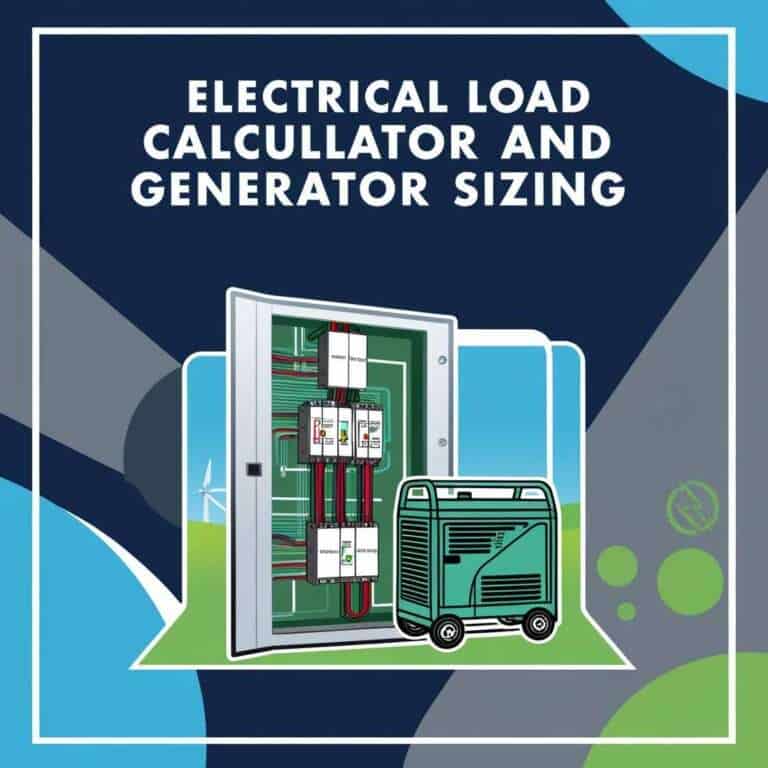Electricity Load Calculator (kVA) According to IEC and NEC
Understanding your total electrical load is the foundation of designing a safe and efficient power system. Whether you are setting up a residential, commercial, or industrial project, knowing the load demand in kilovolt-amperes (kVA) is essential for transformer sizing, generator capacity, and cable selection. That’s where an Electricity Load Calculator (kVA) becomes a crucial tool.
This article explains how an electricity load calculator works, its importance according to international standards like IEC and NEC, and how you can use it to plan your electrical installations accurately.

Table of Contents
What Is an Electricity Load Calculator (kVA)?
An Electricity Load Calculator (kVA) is a tool used to estimate the total apparent power required by all electrical loads in a system. It helps in calculating the total kVA based on the wattage of connected appliances, motors, lighting, and other electrical equipment. Since most electrical devices are rated in watts or kilowatts (kW), and supply systems are designed based on kVA, the calculator bridges this gap by converting kW to kVA using the power factor.
The general formula used in the Electricity Load Calculator (kVA) is:
kVA = kW / Power Factor (pf)
For example, if your total connected load is 100 kW and the power factor is 0.8, the kVA load will be:
kVA = 100 / 0.8 = 125 kVA
This value helps determine the right size of generator, transformer, and wiring required for safe operation.
Electricity Load Calculator (kVA)
Estimate total electrical load in kilovolt-amperes (kVA) based on connected wattage, voltage, and power factor.
Importance of Using an Electricity Load Calculator (kVA)
Accurate load calculation is the foundation of every reliable electrical design. Without proper load assessment, systems can become overloaded, causing frequent tripping, overheating, or even fire hazards. The Electricity Load Calculator (kVA) simplifies this process and ensures that every device receives the correct supply capacity.
Here’s why it’s important:
- Ensures correct sizing of transformers and generators
- Prevents overloading of circuits and cables
- Reduces energy losses and voltage drops
- Helps comply with IEC and NEC standards for electrical safety
- Improves overall system reliability and efficiency
For engineers, consultants, and electricians, this calculator is a time-saving solution to estimate loads without manual errors.
Use our online tool MM to AWG Wire Size Calculator According to IEC and NEC
How Electricity Load Calculator (kVA) Works
The Electricity Load Calculator (kVA) works by taking input data such as wattage, voltage, current, and power factor for each connected device. It then computes the total load in kVA using standard electrical formulas.
Let’s take a closer look at the parameters it considers:
- Wattage (W or kW): The real power consumed by the device.
- Power Factor (pf): The ratio of real power to apparent power. Usually ranges from 0.8 to 1.0 depending on the load type.
- Voltage (V): The line-to-line voltage of the system.
- Current (A): The amount of current drawn by the load.
The formula connecting these values is:
kVA = (Volts × Amps) / 1000 (for single-phase)
kVA = (√3 × Volts × Amps) / 1000 (for three-phase)
By entering these inputs into the calculator, you instantly get the total apparent power required for your installation.
Electricity Load Calculator (kVA) According to IEC Standards
The International Electrotechnical Commission (IEC) sets global standards for electrical installations and equipment. The IEC 60364 standard provides comprehensive guidelines for determining load demand, diversity factors, and conductor sizing.
Under IEC standards, the load calculation should consider:
- Continuous and non-continuous loads
- Simultaneous operation factors
- Power factor correction
- Derating for temperature and installation conditions
For example, if an industrial facility operates multiple machines that rarely run simultaneously, a diversity factor can be applied to reduce the total calculated kVA. This ensures optimal equipment sizing while maintaining safety margins.
The IEC also recommends considering harmonic distortion, voltage drops, and motor starting currents while estimating the total load. The Electricity Load Calculator (kVA) aligns with these principles by allowing users to input realistic operational data instead of nameplate ratings alone.
Use our online tool Busbar Size Calculator – Accurate Sizing According to IEC and NEC Standards
Electricity Load Calculator (kVA) According to NEC Standards
The National Electrical Code (NEC), mainly used in North America, provides detailed rules for calculating electrical loads. NEC Article 220 covers branch circuit, feeder, and service load calculations.
According to NEC:
- General lighting loads are calculated using watts per square foot depending on occupancy type.
- Fixed appliances are added based on their rated power.
- Demand factors are applied to adjust total load.
- Continuous loads must be multiplied by 125% for safe sizing.
The Electricity Load Calculator (kVA) designed with NEC compliance helps users apply these factors automatically, ensuring accurate service sizing for homes, offices, and industrial setups.
For example, if you are calculating load for a commercial building, the calculator can incorporate lighting, HVAC, sockets, and elevator loads with demand and diversity factors to provide a realistic total kVA.
Example Table: Load Calculation Summary
| Load Type | Power (kW) | Power Factor | Calculated kVA | Remarks |
|---|---|---|---|---|
| Lighting Load | 20 | 0.9 | 22.22 | Includes LED fixtures |
| Motor Load | 50 | 0.8 | 62.5 | Includes HVAC motors |
| Socket Load | 10 | 0.95 | 10.53 | Office and small tools |
| Miscellaneous | 5 | 0.9 | 5.55 | Pumps and fans |
| Total Load | 85 | – | 100.8 kVA | For transformer sizing |
This example shows how apparent power varies with the type of load and power factor. The calculator automatically performs these computations, saving time and improving accuracy.
Use our online tool Street Light Voltage Drop Calculator – Accurate Cable Sizing & Power Loss Estimation Tool
Benefits of Using an Online Electricity Load Calculator (kVA)
Using a digital or online calculator brings speed and precision to load assessment. Instead of manual estimation, the calculator instantly provides kVA results based on your inputs.
Some major benefits include:
- Time Efficiency: Quickly estimate total load within seconds.
- Accurate Results: Reduces the risk of under or oversizing equipment.
- IEC and NEC Compliance: Uses standard parameters aligned with international codes.
- User Friendly: Simple interface requiring only basic input values.
- Supports Multiple Systems: Works for single-phase and three-phase systems.
For electrical engineers, contractors, and homeowners, this tool simplifies the process of power system planning without needing complex spreadsheets.
Factors That Affect Electricity Load Calculation
While using an Electricity Load Calculator (kVA), it’s essential to understand that several variables influence the result. These include:
- Type of Load: Resistive, inductive, or capacitive loads have different power factors.
- Simultaneous Usage: Not all loads operate together, hence diversity factors are applied.
- Voltage Fluctuations: Low voltage can increase current, affecting total kVA.
- Temperature and Altitude: These conditions can impact cable and transformer ratings.
- Efficiency of Equipment: Modern energy-efficient devices consume less power.
Accurate data input ensures the calculator gives realistic results, avoiding future system issues.
Applications of Electricity Load Calculator (kVA)
The calculator is widely used across industries and sectors:
- Residential load estimation for homes and apartments
- Commercial load planning for offices, schools, and malls
- Industrial load calculation for factories and plants
- Transformer and generator capacity selection
- Solar and backup system design
In renewable energy systems, such as solar power setups, the calculator helps estimate inverter and battery capacity accurately, ensuring stable operation during peak loads.
Use our online tool Transformer Efficiency Calculator – Calculate Power, Losses & Performance Instantly
Final Thoughts
An Electricity Load Calculator (kVA) is an essential tool for anyone involved in electrical design or energy management. It simplifies complex load assessments and ensures compliance with international standards like IEC and NEC. By providing quick and accurate results, it helps avoid costly design errors and improves system efficiency.
Whether you’re an engineer sizing a transformer or a homeowner planning a solar installation, using the Electricity Load Calculator (kVA) ensures that your electrical system runs safely, efficiently, and within capacity. It’s a modern solution to a traditional challenge—calculating power demand accurately and confidently.
Use our online tool Cable Bending Radius Calculator – Accurate Minimum Bend Radius for Electrical Cables
Follow Us on Social:
Subscribe our Newsletter on Electrical Insights for latest updates from Electrical Engineering Hub
#ElectricityLoadCalculator, #kVACalculator, #ElectricalEngineering, #PowerLoadCalculation, #IECandNEC, #LoadCalculationGuide, #ElectricalDesign, #EnergyCalculator, #ElectricalStandards, #LoadAnalysis, #kVALoad, #ElectricalTools, #EngineeringCalculators, #PowerSystemDesign, #ElectricalSafety
Electricity Load Calculator (kVA) According to IEC and NEC : Electrical Engineering Hub

Easily calculate your total electrical load in kVA using our Electricity Load Calculator (kVA) based on IEC and NEC standards. Perfect for engineers and designers to size equipment, optimize power systems, and ensure compliance with international electrical codes
Price Currency: USD
Operating System: All
Application Category: UtilitiesApplication





